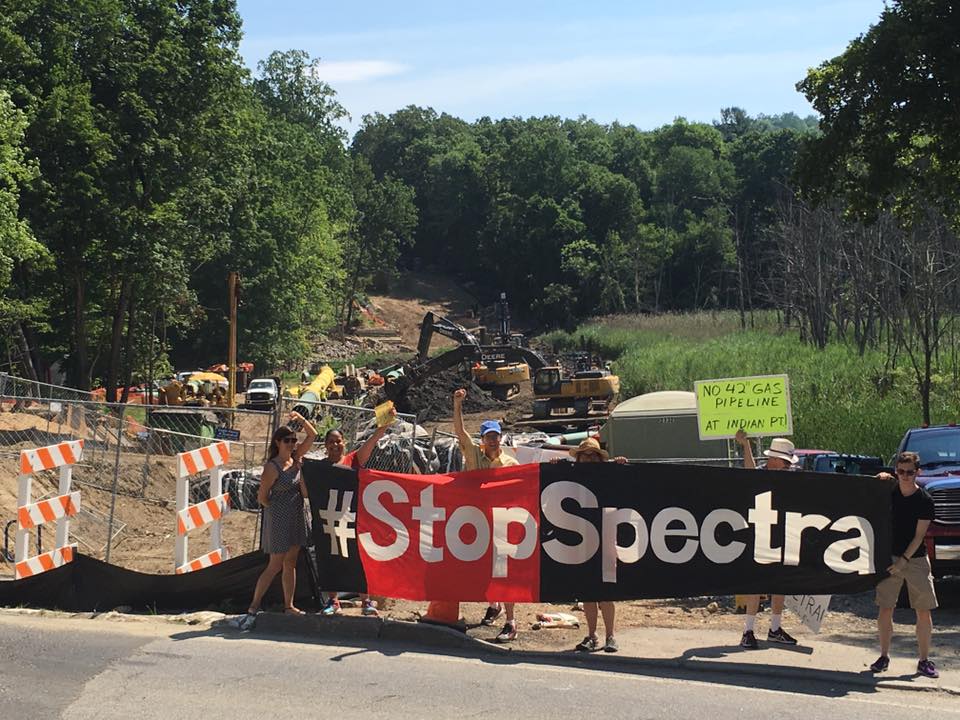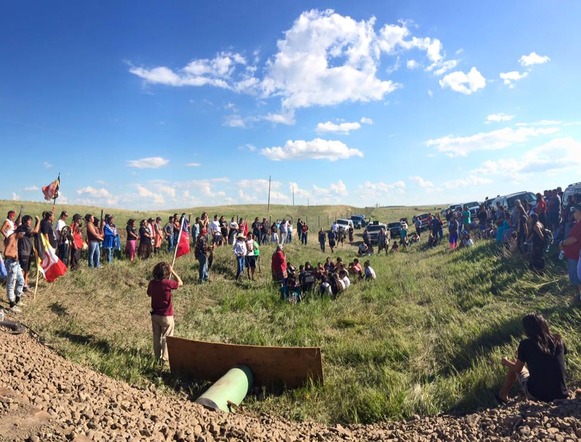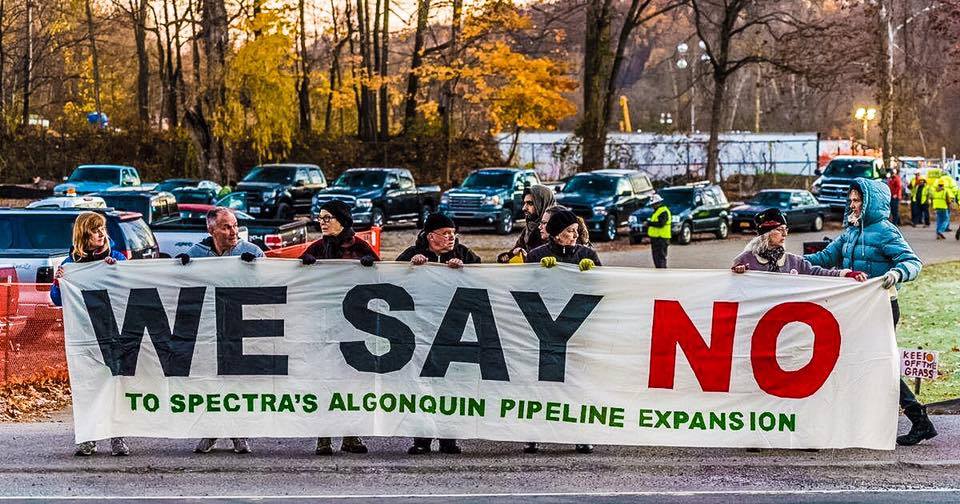
by Deep Green Resistance News Service | Aug 30, 2016 | Obstruction & Occupation
By ResistAIM
Brooklyn, NY – Concerned New Yorkers blocked the doors of National Grid’s downtown Brooklyn office at noon on Monday, August 29 to protest their support of Spectra Energy’s AIM Pipeline, a -brooklyn-demanding-national-grid-stop-support-spectra-energys-dangerous-aim-pipelinehigh-pressure methane gas pipeline that will bring fracked gas from Pennsylvania to New England. Members of 350Brooklyn.org, 350NYC.org, and ResistAIM came together to demand that National Grid end their contract agreement with Spectra Energy. The pipeline’s route runs 105 feet from infrastructure critical to the Indian Point Nuclear Power Plant in New York’s Westchester County. “National Grid is risking the safety of the 17 million people who live within 50 miles of the aging Indian Point reactor so it can sell gas in other parts of the country and the world,” says Mimi Bluestone of 350Brooklyn, one of eight people arrested as part of the day’s action. “Our governor and our US senators have called on the federal government to withdraw its authorization for this pipeline. But without National Grid’s end-of-pipeline agreement to buy this gas, the project could not be economically viable.”
Both elected officials and local residents have repeatedly raised concerns about the pipeline’s safety. This past February, Governor Andrew Cuomo asked the pipeline’s builder, Spectra Energy Corp of Texas, to suspend the project pending an independent safety analysis. “The safety of New Yorkers is the first responsibility of state government,” Cuomo said in making the request. In May, New York Senators Chuck Schumer and Kirsten Gillibrand asked the Federal Energy Regulatory Commission, which has jurisdiction over the pipeline, to halt construction pending such a study. Spectra Energy and FERC have denied the governor’s and the senators’ requests.
The AIM (Algonquin Incremental Market) pipeline is designed solely to deliver natural gas to New England; New York is simply a “pass through” state. The pipeline will enter New York in Rockland County, pass under the Hudson River, and then cross Westchester County en route to Connecticut. Built in the 1970s, Indian Point Nuclear Power complex remains active and contains decades of spent radioactive nuclear fuel, while over 17 million people live within 50 miles of Indian Point. National Grid, a British multinational, expanded into the United States beginning in 2000 by buying a number of local utilities in New England and New York, including the successor to Brooklyn Union Gas. It is a major potential customer for the natural gas that the AIM pipeline would transport to New England and so has the power to determine the financial viability of this project. Last week, National Grid withdrew its petition for a 20-year contract on Spectra’s Access Northeast project; however, National Grid is still expected to purchase gas flowing through the AIM Pipeline and so activists in Rhode Island, Massachusetts and New York are continuing to call on National Grid to cancel the contract.
The AIM pipeline is scheduled to be completed in November 2016, which calls for immediate action. On Monday evening, following the arrests at National Grid, concerned New Yorkers are gathering at the Brooklyn home of Senator Charles Schumer to encourage him to stand with New Yorkers by making a public appearance to denounce the pipeline and calling for a Government Accountability Office (GAO) investigation of the Federal Energy Regulatory Commission – more details can be found HERE.
350.org is a national organization working to keep carbon in the ground and to build a new, more equitable low-carbon economy. Its affiliates like 350NYC and 350Brooklyn work on local issues related to climate change. ResistAIM is a coalition of environmental advocates, Westchester residents and concerned New Yorkers that have been taking nonviolent direct action to stop the AIM Pipeline since November 2015.
A map of the AIM pipeline’s route: http://www.spectraenergy.com/Operations/US-Natural-Gas-Operations/New-Projects-US/Algonquin-Incremental-Market-AIM-Project/
A map of the pipeline’s proximity to the Indian Point Nuclear Power Plant: https://sape2016.org/2015/07/16/nuclear-regulatory-commission-withheld-and-misrepresented-critical-information-used-to-evaluate-and-approve-the-siting-of-the-spectra-aim-pipeline-alongside-indian-point/
For Cuomo’s position: http://www.bloomberg.com/news/articles/2016-02-29/cuomo-seeks-halt-of-spectra-algonquin-gas-line-for-safety-review
For Senator Gillibrand and Schumer’s position: https://www.gillibrand.senate.gov/newsroom/press/release/schumer-gillibrand-urge-ferc-to-suspend-construction-on-aim-pipeline-expansion-until-independent-health-and-safety-studies-are-conducted
For 350NYC: https://350nyc.org/
For 350Brooklyn: http://350brooklyn.org/
For ResistAIM: www.resistaim.com

by Deep Green Resistance News Service | Aug 27, 2016 | Obstruction & Occupation
By Deep Green Resistance Seattle
A coal train entering Bellingham, Washington has been blockaded by a fossil fuel resistance group, including members of Deep Green Resistance. This blockade, part of an ongoing regional campaign against fossil fuels, has been standing strong for six hours – with no end in sight.
Beginning at four PM this afternoon, protestors erected a portable tripod structure in the middle of a rail bridge crossing Mud Bay south of Bellingham. One protester has climbed to the top and will stay until removed by police.
The organizers of the blockade say that fossil fuels must be stopped to save the planet from global warming.
When asked about her motivation for joining the resistance movement, one Deep Green Resistance member responded, “We won’t be complicit in a global catastrophe. The government and the capitalists are working together to kill the planet. We’re going to work together to stop them.”
With two refineries sitting north of town and a tar sands pipeline running underneath, Bellingham has been in the sights of the fossil fuel industry for decades. The struggle to keep fossil fuel transportation out of the small city has been ongoing. The Lummi Nation and other local resisters recently defeated plans for a major coal export terminal. However, coal merchants continue to push for the project.
The protest also delayed passenger trains, but organizers aren’t overly concerned. When asked about possible inconveniences to travelers, a protestor responded, “What’s inconvenient is losing your island to rising sea levels, or having your home flooded in Baton Rouge, or digging mass graves in Pakistan in anticipation of heat waves.” She also noted that Amtrak was notified to minimize delays in passenger transportation.
From Deep Green Resistance Seattle: http://deepgreenresistanceseattle.org/resistance/direct-action/activists-stage-coal-train-blockade-bellingham-train-stopped-5-hours-counting/

by Deep Green Resistance News Service | Aug 22, 2016 | Lobbying
Featured image: Dakota Access Pipeline Protest In North Dakota. Photo Credit: “No Dakota Access in Treaty Territory – Camp of the Sacred Stones”
By International lndian Treaty Council
Ft. Yates, North Dakota, United States: On Thursday, August 18, 2016 the Standing Rock Sioux Tribe and the International Indian Treaty Council (IITC) jointly submitted an urgent action communication to four United Nations (UN) human rights Special Rapporteurs. It cited grave human rights and Treaty violations resulting from the construction of the Dakota Access crude oil pipeline in close proximity to the Standing Rock Reservation by the United States Army Corps of Engineers and Dakota Access LLC, a subsidiary of Texas-based Energy Transfer.
The Standing Rock Sioux Tribe (SRST) stands in firm opposition to the Dakota Access Pipeline. The pipeline would carry nearly half a billion barrels of crude oil a day, and would cross the Missouri River threatening the Tribe’s main water source and sacred places along its path including burials sites. The urgent communication was submitted to UN Special Rapporteurs on the situation of human rights defenders; the Rights of Indigenous Peoples; the human right to safe drinking water and sanitation; and Environment and Human Rights, as well as the Office of the UN High Commissioner for Human Rights. It requests that they urge the United States to halt the human rights violations and uphold its human rights and Treaty obligations to the Standing Rock Tribe. It was also forwarded to key officials in the U.S. State Department, Department of Interior and the White House.
The urgent communication focuses on violations of the UN Declaration on the Rights of Indigenous Peoples, the 1868 Ft. Laramie Treaty and other International human rights standards to which the United States is obligated. It also cites actions against human rights defenders, including arrests and other forms of intimidation, violations of the human right to water, and lack of redress and response using domestic remedies. The submission noted that this action violates Article 32 of the UN Declaration on the Rights of Indigenous Peoples, which affirms the obligation of States to obtain Indigenous Peoples’ free prior and informed consent before development projects affecting their lands, territories or other resources are carried out. The Lakota and Dakota, which includes the SRST, were part of the Sovereign Sioux Nation, which concluded the 1868 Ft. Laramie Treaty with the United States. The United States has legally-binding obligations based on this Treaty to obtain the Lakota and Dakota’s consent before activities are carried out on their Treaty lands.
The urgent communication also highlights environmental racism in violation of the International Convention on the Elimination of all Forms of Racial Discrimination Convention (ICERD) to which the US is legally obligated. It notes that the United States has permitted Energy Transfer to divert the pipeline’s route from near the mainly non-Indigenous population of Bismarck, ND to disproportionately impact the SRST.
A primary concern expressed by the Tribe is potential devastating effects on its primary water source. SRST Chairman Dave Archambault II, who was among those arrested and is also being sued by the company for obstructing the pipeline’s construction, stated on August 15th “I am here to advise anyone that will listen, that the Dakota Access Pipeline is harmful. It will not be just harmful to my people but its intent and construction will harm the water in the Missouri River, which is the only clean and safe river tributary left in the United States.”
In response to the Tribe’s opposition, Dakota Access LLC, the developers of the $3.8 billion, four-state oil pipeline, has waged a concerted campaign to criminalize and intimidate Tribal leaders, Tribal members and their supporters who have consistently been peaceful and non-violent. The IITC and SRST are calling upon the UN Rapporteur on Human Rights Defenders to call upon the United States to immediately cease all arrests and other forms of intimidation, drop any pending lawsuits, and ensure that all legal charges against these human and Treaty Rights defenders be lifted. The urgent action communication cited this case as an example of the criminalization of Indigenous human rights defenders around the world, as noted by various UN bodies.
Despite 28 arrests reported to date, the peaceful protesters have succeeded in temporarily halting the pipeline’s construction. A hearing is currently scheduled for next week in federal court to consider the Tribe’s request for an injunction. Construction has reportedly been halted until the hearing, providing an important initial victory for the Tribe and their supporters.
The joint urgent UN communication requests the intervention of these UN human rights mandate holders to call upon the United States to uphold its statutory, legal, Treaty and human rights obligations and impose an immediate and ongoing moratorium on all pipeline construction until the Treaty and human rights of the Standing Rock Sioux Tribe, including their right to free prior and informed consent, can be ensured.
Editor’s note: for more current news on the Dakota Access Pipeline, see U.S. Government Bans Native American Tribe From Protesting On Their Own Land – Send In Police To Remove Protesters and Dalrymple signs emergency declaration to manage public safety at Dakota Access Pipeline protest near Cannon Ball

by Deep Green Resistance News Service | Aug 6, 2016 | Biodiversity & Habitat Destruction, Education, Lobbying

by Deep Green Resistance News Service | Aug 3, 2016 | Lobbying
By ResistAIM
On Friday, July 29th, a coalition of 21 plaintiffs including local groups Riverkeeper, Sierra Club Lower Hudson, Food & Water Watch NY, Stop the Algonquin Pipeline Expansion (SAPE), and Reynolds Hill, Inc. filed a brief in the U.S. Court of Appeals for the District of Columbia seeking to overturn the Federal Energy Regulatory Commission’s (FERC) March 2015 approval of Spectra Energy’s Algonquin Incremental Markets (AIM) pipeline project. Although many state and local officials, including Governor Andrew Cuomo, both New York Senators and Representatives Nita Lowey and Eliot Engle have come out against the pipeline, so far construction is still moving forward.
The coalition’s brief addresses some of the points they had raised in their Rehearing Request that FERC rejected in January 2016. First it argues that the Commission improperly segmented the Algonquin pipeline expansion by dividing it into three different projects to avoid having to address its full environmental impact. As one Spectra official told an industry journal “you end up with a lot less potential opposition if you do that.” The AIM project is the first of three expansion Spectra plans for the Algonquin pipeline. The other two, Atlantic Bridge and Access Northeast, continue precisely where Aim leaves off to create a greatly enlarged path for fracked gas from Pennsylvania to Canadian export terminals.
Approximately 2,159 feet of the AIM pipeline will run through property that is part of the Indian Point nuclear power plant. The brief challenges the approval of installing the pipeline a little over 100 feet from critical safety structures at the Indian Point. It notes that the Commission relied on findings by Entergy Nuclear Operations, the company that operates Indian Point, and the Nuclear Regulatory Commission (NRC), neither of which have expertise in pipeline safety. Entergy and the NRC had concluded that the AIM Project would not impact safety at Indian Point, a conclusion challenged by both elected officials and independent nuclear and pipeline safety experts.
Lastly the brief argues FERC violated its own regulations by relying on a third-party contractor that had a financial interest in the construction of the AIM Project. FERC relies on third-party contractors to prepare the Environmental Impact Statements required for approving projects. Those contractors are identified by and paid for by the project applicant – in this case Spectra. To avoid conflicts of interest, potential third-party contractors must complete and submit an Organizational Conflict of Interest statement. No such statement has been found in the AIM record however. An investigation has also revealed that NRG, the third-party contractor that prepared the Environmental Impact Statement for AIM, was working for Spectra on another related project at the same time in an apparent violation of FERC regulations.
Nancy Vann, whose property is being taken by eminent domain for the AIM project, said “FERC has only rejected one pipeline project in its entire 40 year history. It’s shameful that the public must take a government agency to court in order to make it do its job. I’m so grateful for the determination of Riverkeeper, SAPE, Food & Water Watch and all of the other coalition members who have persisted in asserting these important issues and I’m looking forward to getting our day in court.”





